Home / Haloform Reaction
Enols and Enolates
Haloform Reaction
Last updated: May 14th, 2025 |
The Haloform Reaction
- When a methyl ketone is treated with base and a halogen (e.g. I2, Br2, or Cl2) it is converted into a carboxylic acid, along with a haloform (HCX3)
- The reaction proceeds through three successive cycles of deprotonation and halogenation at the alpha carbon, followed by addition of base to the carbonyl and expulsion of CX3 as a leaving group.
- This is a rare example of an oxidation of a ketone to a carboxylic acid, which is possible because the (-)CX3 ion is a good leaving group and can be displaced by NaOH.
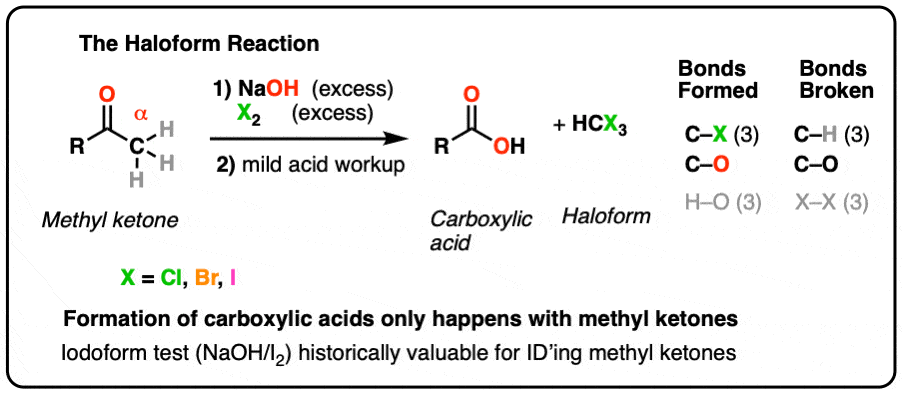
Table of Contents
- Ketones, “Alpha” Carbons, And What It Means To Be “Enolizable”
- Enolates Are Good Nucleophiles: Alpha-Chlorination
- The Haloform Reaction Has “Cookie Monster” Characteristics
- Two More Deprotonation / Chlorination Cycles Give A Trihalomethyl Ketone
- The Coup De Grace: Cleavage Of The Trihalomethyl Ketone With Strong Base
- Summary: The Haloform Reaction
- Notes
- Quiz Yourself!
- (Advanced) References and Further Reading
1. Ketones, “Alpha” Carbons, And What It Means To Be “Enolizable”
A ketone is a carbonyl group (C=O) flanked by two carbon atoms. The carbons directly bonded to the carbonyl carbon are referred to as the “alpha” carbons, those two bonds away are the “beta” carbons, those three bonds away are “gamma“, and so on. [Note 1 re: omega ω]
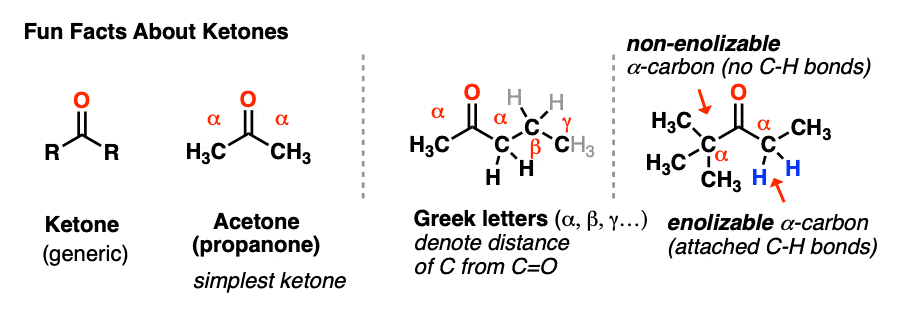
Ketones with C-H bonds on the alpha carbon are “enolizable”; not only is equilibrium with an enol tautomer possible, but strong base can deprotonate the alpha carbon to give its conjugate base, which we call an enolate.
The C-H bonds on the alpha carbons of ketones are unusually acidic (the pKa of the simplest ketone, 2-propanone, is about 19 in water [Note 2 for ref] a) because the negative charge resulting from deprotonation can be delocalized through resonance to the oxygen atom, which due to its higher electronegativity is superior at stabilizing negative charge.
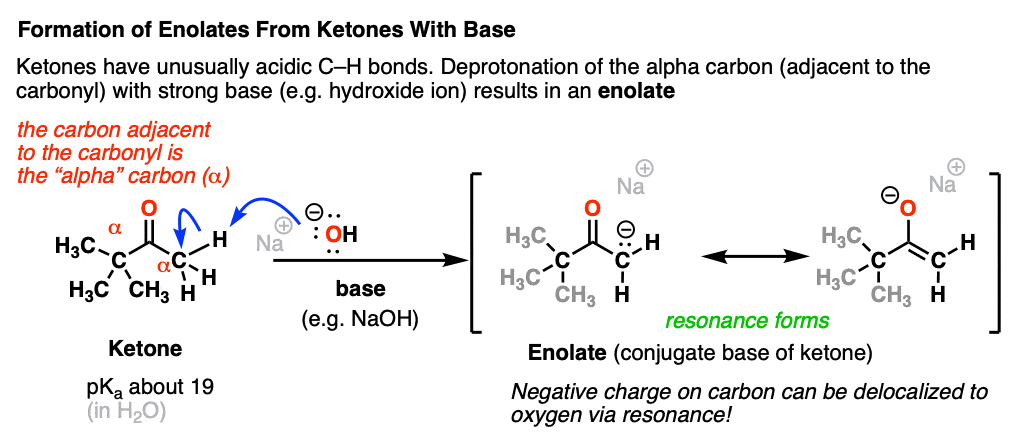
2. Enolates Are Good Nucleophiles
Enolates are good nucleophiles. Interestingly, although the negative charge is more stable on oxygen, enolates tend to react as nucleophiles on the carbon atom [Note 3 – but not always!] . That is, the alpha carbon tends to be where the bonds form. [It’s worth recalling Grossman’s “second-best” rule: the “second-best” resonance form is often the most important for reactivity purposes. This and other useful nuggets can be found in this book ].
Examples of enolates as nucleophiles abound, among them the Aldol and Claisen condensations, the alkylation of enolates, the Michael reaction and others.
Of relevance today is that an enolate in the presence of a halogen such as chlorine (Cl2) will give the “alpha-chloro” ketone, below.
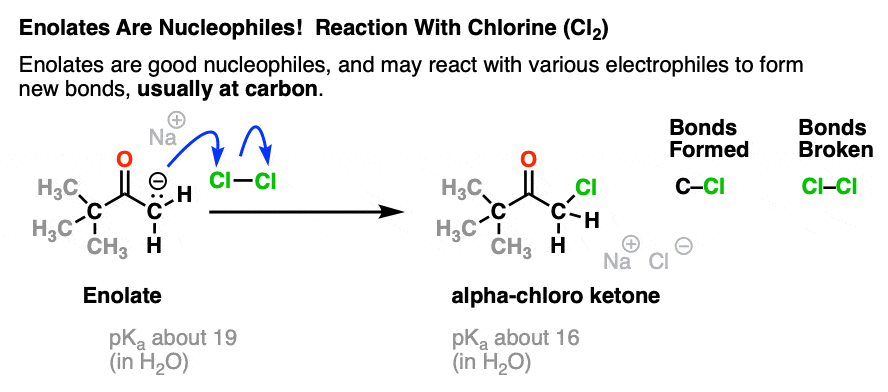
3. The Haloform Reaction Has “Cookie Monster” Characteristics
In the days before our modern spectroscopic techniques, the iodoform test was widely used for the identification of methyl ketones. It’s still used in some undergraduate teaching laboratories because it is cheap and easily done: one merely stirs a ketone with iodine and base (NaOH), and a positive test quickly rewards the chemist with a smelly yellow precipitate. The stinky precipitate is iodoform.
The iodoform test is an example of the haloform reaction, which uses an excess of base (usually hydroxide) and an excess of halogen to produce a carboxylic acid and a haloform.
One thing that makes the haloform reaction interesting is that the first product – the alpha-halo ketone – is itself more acidic than the starting methyl ketone, which means it will out-compete the starting ketone for available base [Remember that one of the key factors that affect acidity is the presence of a nearby electron-withdrawing group, such as a halogen like Cl. ]
After halogenation of its enolate, the resulting dihalo ketone is in turn even more acidic than its two precursors (thanks to the two electron-withdrawing groups on the alpha carbon) which means it will out-compete these ketones for base.
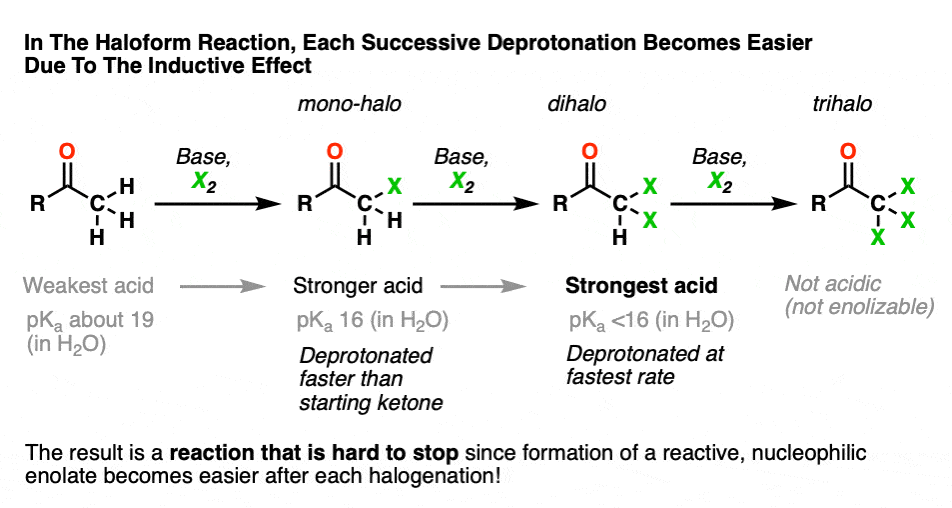
Getting the reaction to stop at “just one” halogenation is a little bit like asking the Cookie Monster to eat “just one” cookie. The process continues until either the Cookie Monster is sated or all the cookies are consumed.
[Two other examples of reactions with “Cookie Monster characteristics” are alkylation of amines, and addition of Grignards to esters]
The Cookie Monster isn’t done until all C-H bonds on the methyl group have been replaced with halogens!
Replacing all C-H bonds with C-Cl bonds results in a non-enolizable ketone which cannot be deprotonated further.
This is generally not what one would consider “carefully controlled”, especially considering the equilibria involved [Note 6].
There are ways of getting alpha-halogenation reactions to stop at adding a single halogen atom, generally by adding a single equivalent of a strong base [e.g. lithium di-isopropylamide, LDA] to form the enolate followed by addition of an electrophilic halogen under carefully controlled conditions. [Note 5 for an example] But that’s not what we’re discussing here.
4. Two More Deprotonation / Chlorination Cycles Give A Trihalomethyl Ketone
Let’s walk through the rest of the mechanism in detail, starting with the alpha-chloro ketone above. Although we’re going to use Cl2 going forward, the reaction also works with Br2 and I2, as well as other sources of electrophilic halogens. [Note 4 ]
Under the conditions of the haloform reaction, three successive deprotonation-halogenation cycles occur in total, so that means that the alpha-chloro has two more cycles to go.
The alpha-chloro ketone formed from NaOH and Cl2 has been estimated to have a pKa of about 16 [Ref], making it 1000 times more acidic than the starting methyl ketone.
So in the presence of NaOH, this chloroketone will be easily deprotonated to give its resulting enolate:

The enolate will then react with any Cl2 present, giving the alpha dichloroketone:
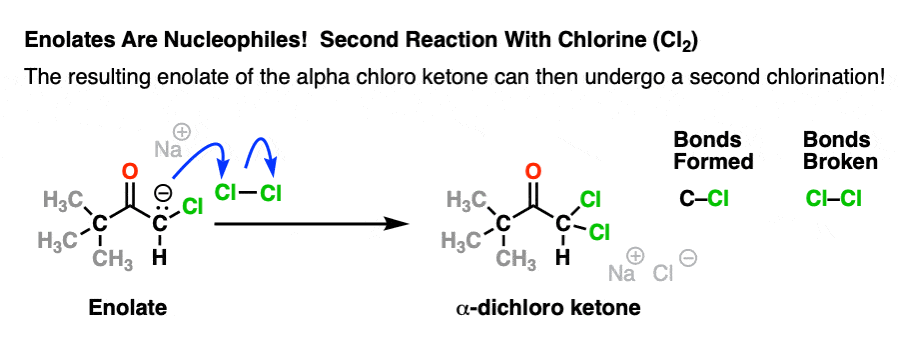
With two electron withdrawing chlorines, this ketone is even more acidic than the mono-chloro; [Note 7] . Deprotonation to give the enolate is even easier:
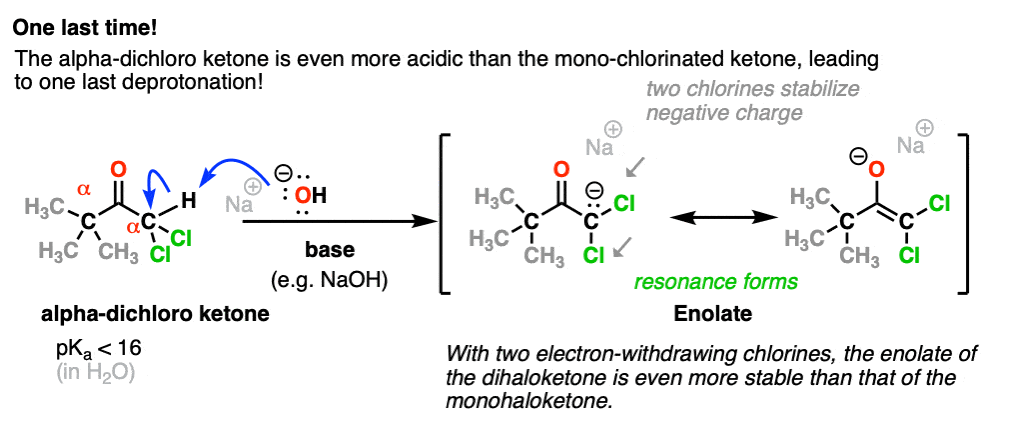
Finally, the third chlorination occurs:
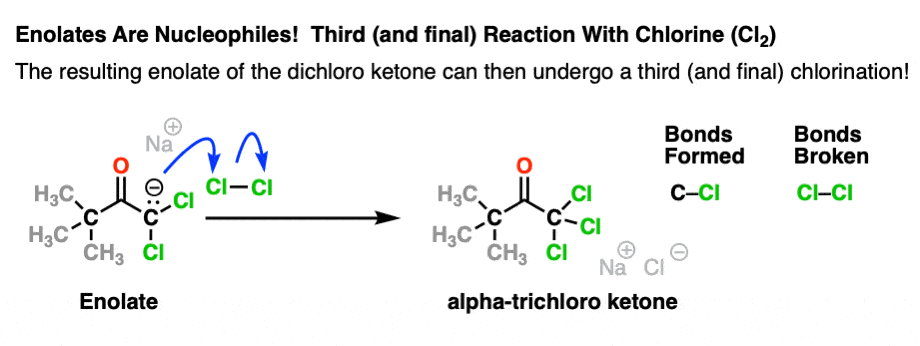
At this point, you might think the reaction is done. After all, there aren’t any more protons for base to remove, right?
5. The Coup De Grace: Cleavage Of The Trihalomethyl Ketone With Strong Base
Now comes the fun part. One final equivalent of base attacks the carbonyl carbon, giving a hydrate [or more specifically, the conjugate base of the hydrate].
Then comes the coup de grace. Normally, alkyl groups are extremely bad leaving groups since carbon is so poor at stabilizing negative charge [recall, leaving groups are weak bases – What Makes A Good Leaving Group]. However, since three hydrogens have been exchanged for three chlorines, this is no longer an ordinary alkyl carbon! This is a carbon attached to three electron-withdrawing atoms, which greatly stabilize any negative charge on the carbon. The result is that (-)CCl3 is actually a decent leaving group! [Note 8]
So in the final step, a new C-O pi bond is formed, and the C-C bond breaks, resulting in a carboxylic acid.
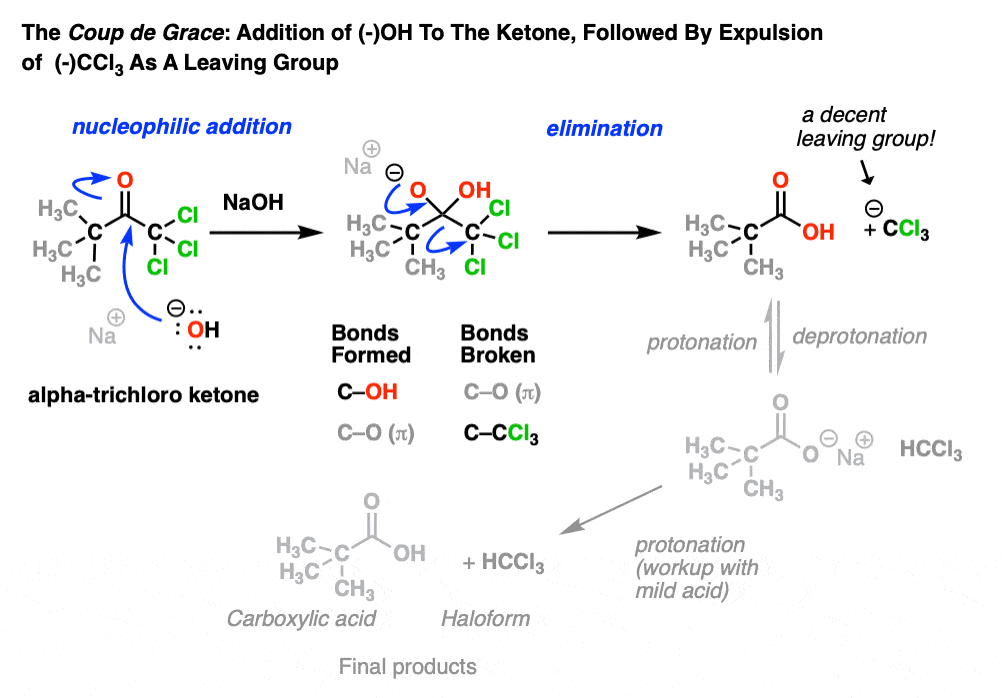
The final step is some bookkeeping. Since we have strong base present (NaOH) as well as the trihalomethyl anion, the resulting carboxylic acid (pKa of about 4) will be deprotonated by the strong base to give water. Once complete the reaction is quenched with mild acid, giving us the carboxylic acid product along with our haloform [chloroform in our case]
6. Summary: The Haloform Reaction
You may recall when learning about oxidation reactions that ketones are generally inert to oxidation whereas aldehydes are oxidized to carboxylic acids. The haloform reaction is a rare example of a net oxidation of a ketone to give a carboxylic acid. (Another example is the Baeyer-Villiger Oxidation which gives esters from ketones)
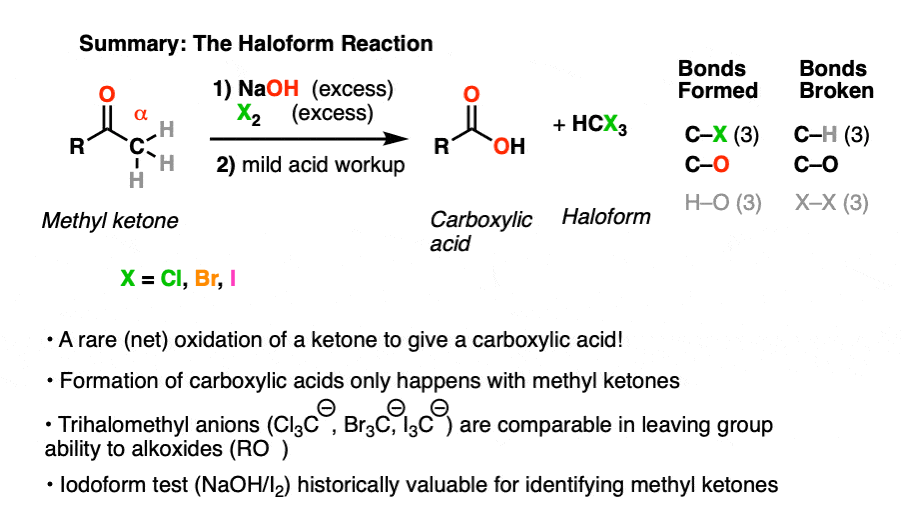
There are some limitations, however. For our purposes, the haloform reaction only work with methyl ketones.
Other alkyl ketones will undergo halogenation but not the cleavage to the carboxylic acid.
Notes
Related Articles
Note 1. Occasionally the term ω (omega) is used to refer to the terminal end of a chain.
Note 2. Source for this is Kresge, via Hans Reich’s page. https://pubs.acs.org/doi/10.1021/ar00170a005
Note 3. A discussion of C- vs. O- nucleophilicity of enolates is beyond what will be covered here at present. For the purposes of introductory organic chemistry, the enolate carbon will almost always be the nucleophile; one exception is the silylation of enolates (e.g. with TMSCl) which happens on oxygen; the O-Si bond is very strong.
Note 4. Although Cl2, Br2, and I2 are shown as electrophiles, in basic solution they are almost certainly present as their hypohalite salts NaOCl, NaOBr and NaOI
Note 5. A good way to do this would be with LDA (1 equivalent) followed by NBS or Br2:

Note 6. The equilibria in this reaction are extremely complex, and many details have been skipped over in the name of simplicity. Not only are there acid-base equilibria with the alpha carbon of the ketone, there are also equilibria between each of the ketones and their hydrates (and deprotonated hydrates). To make things even more fun, there are potential SN2 reactions between hydroxide ion and C-Cl bonds giving hydroxy ketones! This paper gives an accurate idea of the complexities involved.
Note 7. Unable to find a pKa here, but it is certainly less than 16.
Note 8. The pKa of chloroform has been estimated at 15.7 and 24, depending on the method (and, importantly, solvent). [See Ref 11] If you think of (-)CCl3 as being about as good a leaving group as (-)OCH2CH3, you won’t be far off.
Note 9. Thanks to Scott K. Silverman and Alex Speed for help in hunting down the pKa of chloroform.
Quiz Yourself!
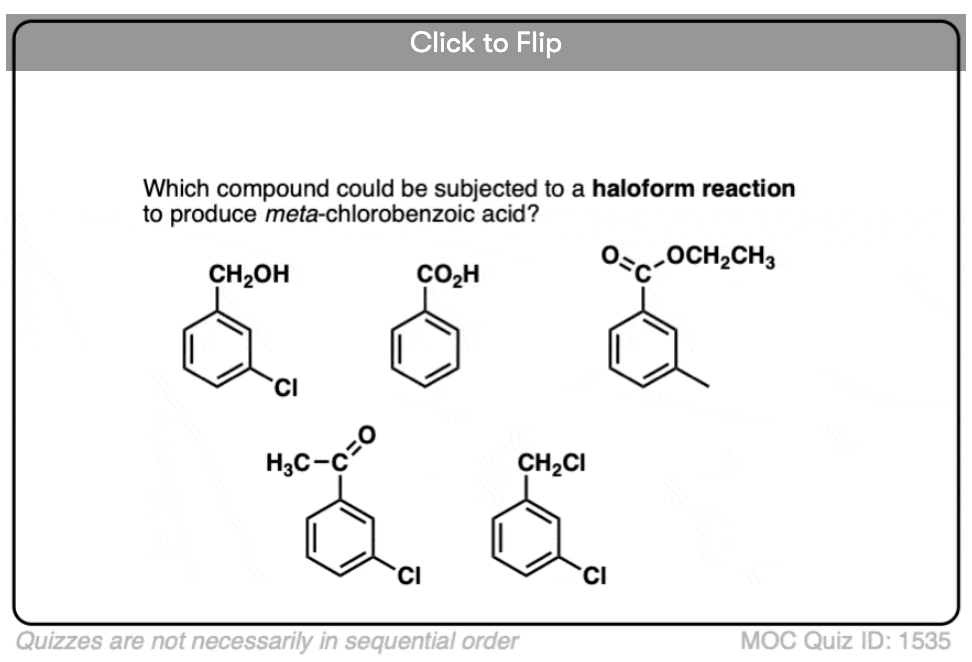
Become a MOC member to see the clickable quiz with answers on the back.
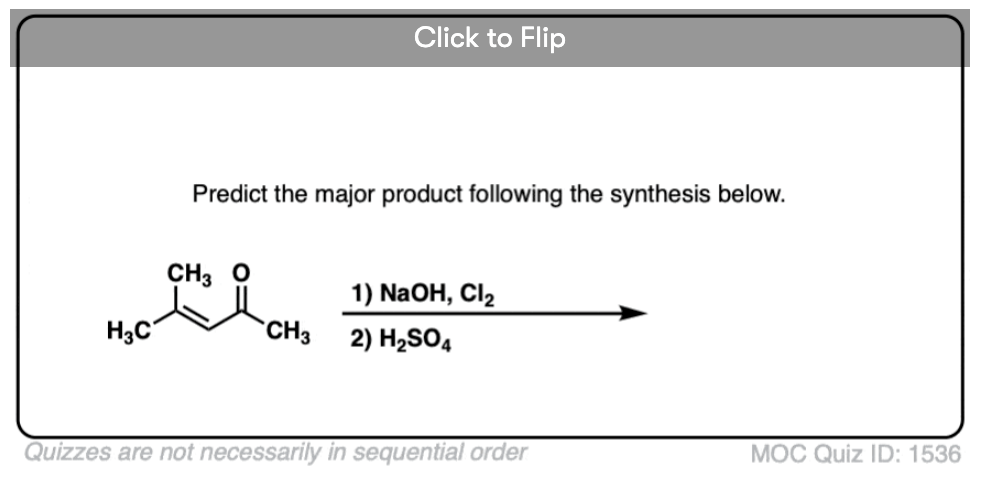
Become a MOC member to see the clickable quiz with answers on the back.

Become a MOC member to see the clickable quiz with answers on the back.

Become a MOC member to see the clickable quiz with answers on the back.
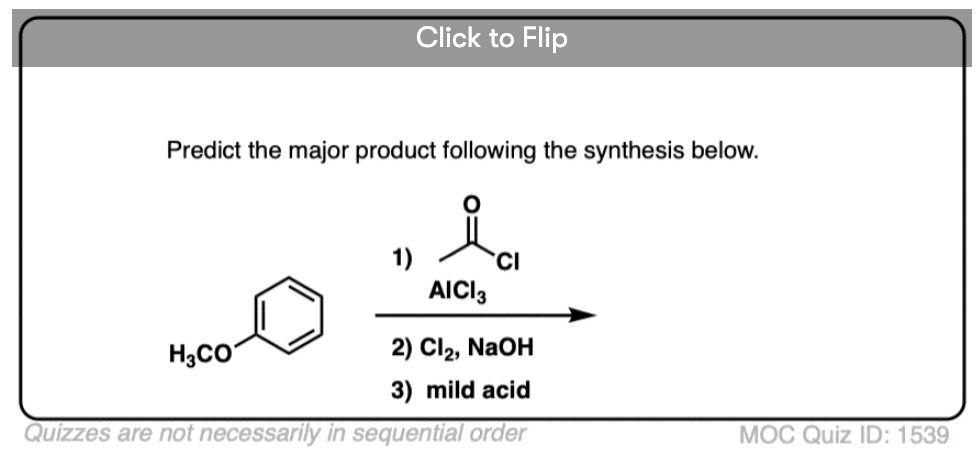
Become a MOC member to see the clickable quiz with answers on the back.
(Advanced) References and Further Reading
- Ueber die Verbindungen, welche durch die Einwirkung des Chlors auf Alkohol, Aether, ölbildendes Gas und Essiggeist entstehen
Justus Liebig
Phys. Chem. 1832, 100 (2), 243-295
The Haloform reaction is one of the oldest reactions known – this paper dates back to 1832! Justus von Liebig reports the reaction of chloral (trichloroacetaldehyde) with Ca(OH)2 to form chloroform (CHCl3) and calcium formate. - The Haloform Reaction.
Reynold C. Fuson and Benton A. Bull
Chemical Reviews 1934 15 (3), 275-309
DOI: 10.1021/cr60052a001
Early review and historical perspective on the haloform reaction.Several examples of haloform reactions, from Organic Syntheses, a collection of reliable methods for the preparation of organic compounds: - β-NAPHTHOIC ACID
M. S. Newman and H. L. HolmesOrg. Synth. 1937, 17, 65 -
β,β-DIMETHYLACRYLIC ACIDLee Irvin Smith, W. W. Prichard, and Leo J. Spillane
Org. Synth. 1943, 23, 27 - β,β-DIMETHYLGLUTARIC ACID
Walter T. Smith and Gerald L. McLeod
Org. Synth. 1951, 31, 40Haloform-like reactions can occur on non-methyl ketones if another electron-withdrawing group is present to stabilize the negative charge on the leaving group!
- 3β-ACETOXYETIENIC ACID
J. Staunton and E. J. Eisenbraun
Org. Synth. 1962, 42, 4 - The chlorination of acetone: a complete kinetic analysis
Peter Guthrie, John Cossar
Canadian Journal of Chemistry, 1986, 64 (6): 1250-1266
DOI: 10.1139/v86-208
The equilibria of the haloform reaction with acetone is studied here in tremendous detail, including rate constants for many of the side-reactions such as hydrate formation. The pKa of chloroacetone is estimated at 15.74 ; no estimate for dichloroacetone is given. - Mechanistic studies on the basic hydrolysis of 2,2,2-trichloro-1-arylethanones
Cesar Zucco, Claudio F. Lima, Marcos C. Rezende, Jose F. Vianna, and Faruk Nome
The Journal of Organic Chemistry 1987 52 (24), 5356-5359
DOI: 1021/jo00233a009
A detailed study on the basic cleavage of 2,2,2-trichloro ketones, which is the second step of the haloform reaction. - Alkaline cleavage of trihaloacetophenones
Peter Guthrie, John Cossar
Canadian Journal of Chemistry, 1990, 68 (9): 1640-1642
DOI: 10.1139/v90-255
This is an extension of the work in ref #3 above, studying tribromo and trifluoro ketones as well. What is interesting here is that despite what one might predict from electronegativity, the cleavage of trifluoroacetophenone is slower than that of trichloroacetophenone, which is slower than that of tribromoacetophenone (1: 2.1 x 10^6 : 2.6 x 10^8). The authors state that this follows from order found in the exchange rates of HCF3, HCCl3, and HCBr3. Also of interest is that the cleavage of the trifluoroaceophenone occurs through a hydrate dianion, while the trichloro and tribromoaceophenones likely cleave via a hydrate mono-anion. - The Relative Rates of Formation of Carbanions by Haloforms
Jack Hine, Norbert W. Burske, Mildred Hine, and Paul B. Langford
Journal of the American Chemical Society 1957 79 (6), 1406-1412
DOI: 10.1021/ja01563a037
Surprise! The haloform reaction is faster with I2 and Br2 than it is with Cl2 (and sources of electrophilic F). “Alpha halogens facilitate carbanion formation in the order I ~ Br > Cl > F. The observed order is thought to be some combination of the inductive effect, polarizability, and d-orbital resonance.” - Acidities of polyfluorinated hydrocarbons. II. Hexafluoropropanes, trifluoroethanes, and haloforms. Intermediate carbanion stability and geometry
Kenneth J. Klabunde and Donald J. Burton
Journal of the American Chemical Society 1972 94 (17), 5985-5990
DOI: 10.1021/ja00772a008
An estimate of the acidity of chloroform, at about 15.7 . Thanks to @sksilverman for the tip. - Aryl trifluoromethyl ketone hydrates as precursors of carboxylic acids and esters
Antonio Delgado, Jon Clardy
Tetrahedron Letters 1992, Volume 33 (20) Pages 2789-2790
DOI: 1016/S0040-4039(00)78858-7
This is a very interesting paper, as it shows that trifluoroacetophenone (which is cheap and readily available) can serve as a convenient source of CF3–. The authors don’t discuss it, but the CF3– could be trapped by other electrophiles and used for synthetic purposes.
00 General Chemistry Review
01 Bonding, Structure, and Resonance
- How Do We Know Methane (CH4) Is Tetrahedral?
- Hybrid Orbitals and Hybridization
- How To Determine Hybridization: A Shortcut
- Orbital Hybridization And Bond Strengths
- Sigma bonds come in six varieties: Pi bonds come in one
- A Key Skill: How to Calculate Formal Charge
- The Four Intermolecular Forces and How They Affect Boiling Points
- 3 Trends That Affect Boiling Points
- How To Use Electronegativity To Determine Electron Density (and why NOT to trust formal charge)
- Introduction to Resonance
- How To Use Curved Arrows To Interchange Resonance Forms
- Evaluating Resonance Forms (1) - The Rule of Least Charges
- How To Find The Best Resonance Structure By Applying Electronegativity
- Evaluating Resonance Structures With Negative Charges
- Evaluating Resonance Structures With Positive Charge
- Exploring Resonance: Pi-Donation
- Exploring Resonance: Pi-acceptors
- In Summary: Evaluating Resonance Structures
- Drawing Resonance Structures: 3 Common Mistakes To Avoid
- How to apply electronegativity and resonance to understand reactivity
- Bond Hybridization Practice
- Structure and Bonding Practice Quizzes
- Resonance Structures Practice
02 Acid Base Reactions
- Introduction to Acid-Base Reactions
- Acid Base Reactions In Organic Chemistry
- The Stronger The Acid, The Weaker The Conjugate Base
- Walkthrough of Acid-Base Reactions (3) - Acidity Trends
- Five Key Factors That Influence Acidity
- Acid-Base Reactions: Introducing Ka and pKa
- How to Use a pKa Table
- The pKa Table Is Your Friend
- A Handy Rule of Thumb for Acid-Base Reactions
- Acid Base Reactions Are Fast
- pKa Values Span 60 Orders Of Magnitude
- How Protonation and Deprotonation Affect Reactivity
- Acid Base Practice Problems
03 Alkanes and Nomenclature
- Meet the (Most Important) Functional Groups
- Condensed Formulas: Deciphering What the Brackets Mean
- Hidden Hydrogens, Hidden Lone Pairs, Hidden Counterions
- Don't Be Futyl, Learn The Butyls
- Primary, Secondary, Tertiary, Quaternary In Organic Chemistry
- Branching, and Its Affect On Melting and Boiling Points
- The Many, Many Ways of Drawing Butane
- Wedge And Dash Convention For Tetrahedral Carbon
- Common Mistakes in Organic Chemistry: Pentavalent Carbon
- Table of Functional Group Priorities for Nomenclature
- Summary Sheet - Alkane Nomenclature
- Organic Chemistry IUPAC Nomenclature Demystified With A Simple Puzzle Piece Approach
- Boiling Point Quizzes
- Organic Chemistry Nomenclature Quizzes
04 Conformations and Cycloalkanes
- Staggered vs Eclipsed Conformations of Ethane
- Conformational Isomers of Propane
- Newman Projection of Butane (and Gauche Conformation)
- Introduction to Cycloalkanes
- Geometric Isomers In Small Rings: Cis And Trans Cycloalkanes
- Calculation of Ring Strain In Cycloalkanes
- Cycloalkanes - Ring Strain In Cyclopropane And Cyclobutane
- Cyclohexane Conformations
- Cyclohexane Chair Conformation: An Aerial Tour
- How To Draw The Cyclohexane Chair Conformation
- The Cyclohexane Chair Flip
- The Cyclohexane Chair Flip - Energy Diagram
- Substituted Cyclohexanes - Axial vs Equatorial
- Ranking The Bulkiness Of Substituents On Cyclohexanes: "A-Values"
- Cyclohexane Chair Conformation Stability: Which One Is Lower Energy?
- Fused Rings - Cis-Decalin and Trans-Decalin
- Naming Bicyclic Compounds - Fused, Bridged, and Spiro
- Bredt's Rule (And Summary of Cycloalkanes)
- Newman Projection Practice
- Cycloalkanes Practice Problems
05 A Primer On Organic Reactions
- The Most Important Question To Ask When Learning a New Reaction
- Curved Arrows (for reactions)
- Nucleophiles and Electrophiles
- The Three Classes of Nucleophiles
- Nucleophilicity vs. Basicity
- What Makes A Good Nucleophile?
- What Makes A Good Leaving Group?
- 3 Factors That Stabilize Carbocations
- Equilibrium and Energy Relationships
- 7 Factors that stabilize negative charge in organic chemistry
- 7 Factors That Stabilize Positive Charge in Organic Chemistry
- What's a Transition State?
- Hammond's Postulate
- Learning Organic Chemistry Reactions: A Checklist (PDF)
- Introduction to Oxidative Cleavage Reactions
06 Free Radical Reactions
- Bond Dissociation Energies = Homolytic Cleavage
- Free Radical Reactions
- 3 Factors That Stabilize Free Radicals
- What Factors Destabilize Free Radicals?
- Bond Strengths And Radical Stability
- Free Radical Initiation: Why Is "Light" Or "Heat" Required?
- Initiation, Propagation, Termination
- Monochlorination Products Of Propane, Pentane, And Other Alkanes
- Selectivity In Free Radical Reactions
- Selectivity in Free Radical Reactions: Bromination vs. Chlorination
- Halogenation At Tiffany's
- Allylic Bromination
- Bonus Topic: Allylic Rearrangements
- In Summary: Free Radicals
- Synthesis (2) - Reactions of Alkanes
- Free Radicals Practice Quizzes
07 Stereochemistry and Chirality
- Types of Isomers: Constitutional Isomers, Stereoisomers, Enantiomers, and Diastereomers
- How To Draw The Enantiomer Of A Chiral Molecule
- How To Draw A Bond Rotation
- Introduction to Assigning (R) and (S): The Cahn-Ingold-Prelog Rules
- Assigning Cahn-Ingold-Prelog (CIP) Priorities (2) - The Method of Dots
- Enantiomers vs Diastereomers vs The Same? Two Methods For Solving Problems
- Assigning R/S To Newman Projections (And Converting Newman To Line Diagrams)
- How To Determine R and S Configurations On A Fischer Projection
- The Meso Trap
- Optical Rotation, Optical Activity, and Specific Rotation
- Optical Purity and Enantiomeric Excess
- What's a Racemic Mixture?
- Chiral Allenes And Chiral Axes
- Stereochemistry Practice Problems and Quizzes
08 Substitution Reactions
- Nucleophilic Substitution Reactions - Introduction
- Two Types of Nucleophilic Substitution Reactions
- The SN2 Mechanism
- Why the SN2 Reaction Is Powerful
- The SN1 Mechanism
- The Conjugate Acid Is A Better Leaving Group
- Comparing the SN1 and SN2 Reactions
- Polar Protic? Polar Aprotic? Nonpolar? All About Solvents
- Steric Hindrance is Like a Fat Goalie
- Common Blind Spot: Intramolecular Reactions
- Substitution Practice - SN1
- Substitution Practice - SN2
09 Elimination Reactions
- Elimination Reactions (1): Introduction And The Key Pattern
- Elimination Reactions (2): The Zaitsev Rule
- Elimination Reactions Are Favored By Heat
- Two Elimination Reaction Patterns
- The E1 Reaction
- The E2 Mechanism
- E1 vs E2: Comparing the E1 and E2 Reactions
- Antiperiplanar Relationships: The E2 Reaction and Cyclohexane Rings
- Bulky Bases in Elimination Reactions
- Comparing the E1 vs SN1 Reactions
- Elimination (E1) Reactions With Rearrangements
- E1cB - Elimination (Unimolecular) Conjugate Base
- Elimination (E1) Practice Problems And Solutions
- Elimination (E2) Practice Problems and Solutions
10 Rearrangements
11 SN1/SN2/E1/E2 Decision
- Identifying Where Substitution and Elimination Reactions Happen
- Deciding SN1/SN2/E1/E2 (1) - The Substrate
- Deciding SN1/SN2/E1/E2 (2) - The Nucleophile/Base
- SN1 vs E1 and SN2 vs E2 : The Temperature
- Deciding SN1/SN2/E1/E2 - The Solvent
- Wrapup: The Key Factors For Determining SN1/SN2/E1/E2
- Alkyl Halide Reaction Map And Summary
- SN1 SN2 E1 E2 Practice Problems
12 Alkene Reactions
- E and Z Notation For Alkenes (+ Cis/Trans)
- Alkene Stability
- Alkene Addition Reactions: "Regioselectivity" and "Stereoselectivity" (Syn/Anti)
- Stereoselective and Stereospecific Reactions
- Hydrohalogenation of Alkenes and Markovnikov's Rule
- Hydration of Alkenes With Aqueous Acid
- Rearrangements in Alkene Addition Reactions
- Halogenation of Alkenes and Halohydrin Formation
- Oxymercuration Demercuration of Alkenes
- Hydroboration Oxidation of Alkenes
- m-CPBA (meta-chloroperoxybenzoic acid)
- OsO4 (Osmium Tetroxide) for Dihydroxylation of Alkenes
- Palladium on Carbon (Pd/C) for Catalytic Hydrogenation of Alkenes
- Cyclopropanation of Alkenes
- A Fourth Alkene Addition Pattern - Free Radical Addition
- Alkene Reactions: Ozonolysis
- Summary: Three Key Families Of Alkene Reaction Mechanisms
- Synthesis (4) - Alkene Reaction Map, Including Alkyl Halide Reactions
- Alkene Reactions Practice Problems
13 Alkyne Reactions
- Acetylides from Alkynes, And Substitution Reactions of Acetylides
- Partial Reduction of Alkynes With Lindlar's Catalyst
- Partial Reduction of Alkynes With Na/NH3 To Obtain Trans Alkenes
- Alkyne Hydroboration With "R2BH"
- Hydration and Oxymercuration of Alkynes
- Hydrohalogenation of Alkynes
- Alkyne Halogenation: Bromination and Chlorination of Alkynes
- Alkyne Reactions - The "Concerted" Pathway
- Alkenes To Alkynes Via Halogenation And Elimination Reactions
- Alkynes Are A Blank Canvas
- Synthesis (5) - Reactions of Alkynes
- Alkyne Reactions Practice Problems With Answers
14 Alcohols, Epoxides and Ethers
- Alcohols - Nomenclature and Properties
- Alcohols Can Act As Acids Or Bases (And Why It Matters)
- Alcohols - Acidity and Basicity
- The Williamson Ether Synthesis
- Ethers From Alkenes, Tertiary Alkyl Halides and Alkoxymercuration
- Alcohols To Ethers via Acid Catalysis
- Cleavage Of Ethers With Acid
- Epoxides - The Outlier Of The Ether Family
- Opening of Epoxides With Acid
- Epoxide Ring Opening With Base
- Making Alkyl Halides From Alcohols
- Tosylates And Mesylates
- PBr3 and SOCl2
- Elimination Reactions of Alcohols
- Elimination of Alcohols To Alkenes With POCl3
- Alcohol Oxidation: "Strong" and "Weak" Oxidants
- Demystifying The Mechanisms of Alcohol Oxidations
- Protecting Groups For Alcohols
- Thiols And Thioethers
- Calculating the oxidation state of a carbon
- Oxidation and Reduction in Organic Chemistry
- Oxidation Ladders
- SOCl2 Mechanism For Alcohols To Alkyl Halides: SN2 versus SNi
- Alcohol Reactions Roadmap (PDF)
- Alcohol Reaction Practice Problems
- Epoxide Reaction Quizzes
- Oxidation and Reduction Practice Quizzes
15 Organometallics
- What's An Organometallic?
- Formation of Grignard and Organolithium Reagents
- Organometallics Are Strong Bases
- Reactions of Grignard Reagents
- Protecting Groups In Grignard Reactions
- Synthesis Problems Involving Grignard Reagents
- Grignard Reactions And Synthesis (2)
- Organocuprates (Gilman Reagents): How They're Made
- Gilman Reagents (Organocuprates): What They're Used For
- The Heck, Suzuki, and Olefin Metathesis Reactions (And Why They Don't Belong In Most Introductory Organic Chemistry Courses)
- Reaction Map: Reactions of Organometallics
- Grignard Practice Problems
16 Spectroscopy
- Degrees of Unsaturation (or IHD, Index of Hydrogen Deficiency)
- Conjugation And Color (+ How Bleach Works)
- Introduction To UV-Vis Spectroscopy
- UV-Vis Spectroscopy: Absorbance of Carbonyls
- UV-Vis Spectroscopy: Practice Questions
- Bond Vibrations, Infrared Spectroscopy, and the "Ball and Spring" Model
- Infrared Spectroscopy: A Quick Primer On Interpreting Spectra
- IR Spectroscopy: 4 Practice Problems
- 1H NMR: How Many Signals?
- Homotopic, Enantiotopic, Diastereotopic
- Diastereotopic Protons in 1H NMR Spectroscopy: Examples
- 13-C NMR - How Many Signals
- Liquid Gold: Pheromones In Doe Urine
- Natural Product Isolation (1) - Extraction
- Natural Product Isolation (2) - Purification Techniques, An Overview
- Structure Determination Case Study: Deer Tarsal Gland Pheromone
17 Dienes and MO Theory
- What To Expect In Organic Chemistry 2
- Are these molecules conjugated?
- Conjugation And Resonance In Organic Chemistry
- Bonding And Antibonding Pi Orbitals
- Molecular Orbitals of The Allyl Cation, Allyl Radical, and Allyl Anion
- Pi Molecular Orbitals of Butadiene
- Reactions of Dienes: 1,2 and 1,4 Addition
- Thermodynamic and Kinetic Products
- More On 1,2 and 1,4 Additions To Dienes
- s-cis and s-trans
- The Diels-Alder Reaction
- Cyclic Dienes and Dienophiles in the Diels-Alder Reaction
- Stereochemistry of the Diels-Alder Reaction
- Exo vs Endo Products In The Diels Alder: How To Tell Them Apart
- HOMO and LUMO In the Diels Alder Reaction
- Why Are Endo vs Exo Products Favored in the Diels-Alder Reaction?
- Diels-Alder Reaction: Kinetic and Thermodynamic Control
- The Retro Diels-Alder Reaction
- The Intramolecular Diels Alder Reaction
- Regiochemistry In The Diels-Alder Reaction
- The Cope and Claisen Rearrangements
- Electrocyclic Reactions
- Electrocyclic Ring Opening And Closure (2) - Six (or Eight) Pi Electrons
- Diels Alder Practice Problems
- Molecular Orbital Theory Practice
18 Aromaticity
- Introduction To Aromaticity
- Rules For Aromaticity
- Huckel's Rule: What Does 4n+2 Mean?
- Aromatic, Non-Aromatic, or Antiaromatic? Some Practice Problems
- Antiaromatic Compounds and Antiaromaticity
- The Pi Molecular Orbitals of Benzene
- The Pi Molecular Orbitals of Cyclobutadiene
- Frost Circles
- Aromaticity Practice Quizzes
19 Reactions of Aromatic Molecules
- Electrophilic Aromatic Substitution: Introduction
- Activating and Deactivating Groups In Electrophilic Aromatic Substitution
- Electrophilic Aromatic Substitution - The Mechanism
- Ortho-, Para- and Meta- Directors in Electrophilic Aromatic Substitution
- Understanding Ortho, Para, and Meta Directors
- Why are halogens ortho- para- directors?
- Disubstituted Benzenes: The Strongest Electron-Donor "Wins"
- Electrophilic Aromatic Substitutions (1) - Halogenation of Benzene
- Electrophilic Aromatic Substitutions (2) - Nitration and Sulfonation
- EAS Reactions (3) - Friedel-Crafts Acylation and Friedel-Crafts Alkylation
- Intramolecular Friedel-Crafts Reactions
- Nucleophilic Aromatic Substitution (NAS)
- Nucleophilic Aromatic Substitution (2) - The Benzyne Mechanism
- Reactions on the "Benzylic" Carbon: Bromination And Oxidation
- The Wolff-Kishner, Clemmensen, And Other Carbonyl Reductions
- More Reactions on the Aromatic Sidechain: Reduction of Nitro Groups and the Baeyer Villiger
- Aromatic Synthesis (1) - "Order Of Operations"
- Synthesis of Benzene Derivatives (2) - Polarity Reversal
- Aromatic Synthesis (3) - Sulfonyl Blocking Groups
- Birch Reduction
- Synthesis (7): Reaction Map of Benzene and Related Aromatic Compounds
- Aromatic Reactions and Synthesis Practice
- Electrophilic Aromatic Substitution Practice Problems
20 Aldehydes and Ketones
- What's The Alpha Carbon In Carbonyl Compounds?
- Nucleophilic Addition To Carbonyls
- Aldehydes and Ketones: 14 Reactions With The Same Mechanism
- Sodium Borohydride (NaBH4) Reduction of Aldehydes and Ketones
- Grignard Reagents For Addition To Aldehydes and Ketones
- Wittig Reaction
- Hydrates, Hemiacetals, and Acetals
- Imines - Properties, Formation, Reactions, and Mechanisms
- All About Enamines
- Breaking Down Carbonyl Reaction Mechanisms: Reactions of Anionic Nucleophiles (Part 2)
- Aldehydes Ketones Reaction Practice
21 Carboxylic Acid Derivatives
- Nucleophilic Acyl Substitution (With Negatively Charged Nucleophiles)
- Addition-Elimination Mechanisms With Neutral Nucleophiles (Including Acid Catalysis)
- Basic Hydrolysis of Esters - Saponification
- Transesterification
- Proton Transfer
- Fischer Esterification - Carboxylic Acid to Ester Under Acidic Conditions
- Lithium Aluminum Hydride (LiAlH4) For Reduction of Carboxylic Acid Derivatives
- LiAlH[Ot-Bu]3 For The Reduction of Acid Halides To Aldehydes
- Di-isobutyl Aluminum Hydride (DIBAL) For The Partial Reduction of Esters and Nitriles
- Amide Hydrolysis
- Thionyl Chloride (SOCl2) And Conversion of Carboxylic Acids to Acid Halides
- Diazomethane (CH2N2)
- Carbonyl Chemistry: Learn Six Mechanisms For the Price Of One
- Making Music With Mechanisms (PADPED)
- Carboxylic Acid Derivatives Practice Questions
22 Enols and Enolates
- Keto-Enol Tautomerism
- Enolates - Formation, Stability, and Simple Reactions
- Kinetic Versus Thermodynamic Enolates
- Aldol Addition and Condensation Reactions
- Reactions of Enols - Acid-Catalyzed Aldol, Halogenation, and Mannich Reactions
- Claisen Condensation and Dieckmann Condensation
- Decarboxylation
- The Malonic Ester and Acetoacetic Ester Synthesis
- The Michael Addition Reaction and Conjugate Addition
- The Robinson Annulation
- Haloform Reaction
- The Hell–Volhard–Zelinsky Reaction
- Enols and Enolates Practice Quizzes
23 Amines
- The Amide Functional Group: Properties, Synthesis, and Nomenclature
- Basicity of Amines And pKaH
- 5 Key Basicity Trends of Amines
- The Mesomeric Effect And Aromatic Amines
- Nucleophilicity of Amines
- Alkylation of Amines (Sucks!)
- Reductive Amination
- The Gabriel Synthesis
- Some Reactions of Azides
- The Hofmann Elimination
- The Hofmann and Curtius Rearrangements
- The Cope Elimination
- Protecting Groups for Amines - Carbamates
- The Strecker Synthesis of Amino Acids
- Introduction to Peptide Synthesis
- Reactions of Diazonium Salts: Sandmeyer and Related Reactions
- Amine Practice Questions
24 Carbohydrates
- D and L Notation For Sugars
- Pyranoses and Furanoses: Ring-Chain Tautomerism In Sugars
- What is Mutarotation?
- Reducing Sugars
- The Big Damn Post Of Carbohydrate-Related Chemistry Definitions
- The Haworth Projection
- Converting a Fischer Projection To A Haworth (And Vice Versa)
- Reactions of Sugars: Glycosylation and Protection
- The Ruff Degradation and Kiliani-Fischer Synthesis
- Isoelectric Points of Amino Acids (and How To Calculate Them)
- Carbohydrates Practice
- Amino Acid Quizzes
25 Fun and Miscellaneous
- A Gallery of Some Interesting Molecules From Nature
- Screw Organic Chemistry, I'm Just Going To Write About Cats
- On Cats, Part 1: Conformations and Configurations
- On Cats, Part 2: Cat Line Diagrams
- On Cats, Part 4: Enantiocats
- On Cats, Part 6: Stereocenters
- Organic Chemistry Is Shit
- The Organic Chemistry Behind "The Pill"
- Maybe they should call them, "Formal Wins" ?
- Why Do Organic Chemists Use Kilocalories?
- The Principle of Least Effort
- Organic Chemistry GIFS - Resonance Forms
- Reproducibility In Organic Chemistry
- What Holds The Nucleus Together?
- How Reactions Are Like Music
- Organic Chemistry and the New MCAT
26 Organic Chemistry Tips and Tricks
- Common Mistakes: Formal Charges Can Mislead
- Partial Charges Give Clues About Electron Flow
- Draw The Ugly Version First
- Organic Chemistry Study Tips: Learn the Trends
- The 8 Types of Arrows In Organic Chemistry, Explained
- Top 10 Skills To Master Before An Organic Chemistry 2 Final
- Common Mistakes with Carbonyls: Carboxylic Acids... Are Acids!
- Planning Organic Synthesis With "Reaction Maps"
- Alkene Addition Pattern #1: The "Carbocation Pathway"
- Alkene Addition Pattern #2: The "Three-Membered Ring" Pathway
- Alkene Addition Pattern #3: The "Concerted" Pathway
- Number Your Carbons!
- The 4 Major Classes of Reactions in Org 1
- How (and why) electrons flow
- Grossman's Rule
- Three Exam Tips
- A 3-Step Method For Thinking Through Synthesis Problems
- Putting It Together
- Putting Diels-Alder Products in Perspective
- The Ups and Downs of Cyclohexanes
- The Most Annoying Exceptions in Org 1 (Part 1)
- The Most Annoying Exceptions in Org 1 (Part 2)
- The Marriage May Be Bad, But the Divorce Still Costs Money
- 9 Nomenclature Conventions To Know
- Nucleophile attacks Electrophile
27 Case Studies of Successful O-Chem Students
- Success Stories: How Corina Got The The "Hard" Professor - And Got An A+ Anyway
- How Helena Aced Organic Chemistry
- From a "Drop" To B+ in Org 2 – How A Hard Working Student Turned It Around
- How Serge Aced Organic Chemistry
- Success Stories: How Zach Aced Organic Chemistry 1
- Success Stories: How Kari Went From C– to B+
- How Esther Bounced Back From a "C" To Get A's In Organic Chemistry 1 And 2
- How Tyrell Got The Highest Grade In Her Organic Chemistry Course
- This Is Why Students Use Flashcards
- Success Stories: How Stu Aced Organic Chemistry
- How John Pulled Up His Organic Chemistry Exam Grades
- Success Stories: How Nathan Aced Organic Chemistry (Without It Taking Over His Life)
- How Chris Aced Org 1 and Org 2
- Interview: How Jay Got an A+ In Organic Chemistry
- How to Do Well in Organic Chemistry: One Student's Advice
- "America's Top TA" Shares His Secrets For Teaching O-Chem
- "Organic Chemistry Is Like..." - A Few Metaphors
- How To Do Well In Organic Chemistry: Advice From A Tutor
- Guest post: "I went from being afraid of tests to actually looking forward to them".
If we have ethyl methyl ketone, when we treat with NaOH, we will majorly form the thermodynamic enolate, so how will any haloform reaction take place?
Is it possible to halogenate the other side after the compound is tuned in a carboxylic acid with the same technique?
Not under these conditions. The carboxylate is already negatively charged, and a second deprotonation will make a di-anion which is very difficult to do. It can be done but requires a very strong base (n-BuLi).
Thanks! I hope for many more visits to this website after my entrance exams. So comprehensive.
How does the non methyl ketone haloform reaction work ?
Same as the methyl version, except that the leaving group in this case is a carbon attached to two halogens (not 3) , which is then protonated.